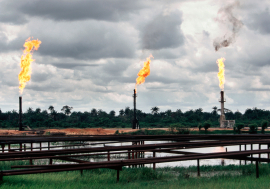The Nigerian government on 30 July 2021 submitted to the United Nations Framework Convention on Climate Change (UNFCCC) its first Nationally Determined Contributions (NDC) - the heart of the Paris Agreement encapsulating the post-2020 climate actions by countries to reduce greenhouse gas emission and adapt to the impacts of climate change.
The ratification reinforces President Muhammadu Buhari’s 2016 commitment to cut emissions by 45 per cent by 2030. It also signalled the government’s commitment to actions that mitigate or reverse the effects of the climate crisis.
The effects of climate change are stark in Nigeria, including frequent massive floods.
For example, in 2012, rivers burst their banks and submerged vast lands in 30 of the country’s 36 states, killing over 400 people and displacing 1.3 million others. That disaster resulted in an estimated $17 billion damage, according to the Nigeria’s National Emergency Management Agency (NEMA).
In 2019, a total of 277,555 people were affected by floods and 158 were killed. In 2020 the number of those affected by floods rose to 2,353,647 resulting in the deaths of 69 people, according to Muhammadu Muhammed, NEMA’s former head, at the unveiling of the 2021 annual flood outlook by the Nigeria Hydrological Services Agency (NHSA).
Reports paint bleak outlook
The NHSA outlook report had predicted that 27 states across the country (see box) were at substantial risk of floods in 2021.
The coastal states of Bayelsa, Delta and highly populated Lagos (23 million people) were projected to be particularly susceptible to floods due to a rise in sea level and tidal surge.
In July 2021, NEMA warned Lagos residents to observe safety precautions because floods had submerged many parts of the state with about 4,000 residents displaced.
The NHSA flood outlook is in sync with the recently released report by the Sixth Intergovernmental Panel on Climate Change (IPCC) titled, Climate Change 2021: The Physical Science Basis.
The IPCC report observes an increase in river flooding across countries in West Africa and projects “increases in mean wind speed; increase in heavy precipitation and pluvial flooding.”
Flood victims in Nigeria are taken aback by the intensity and relentlessness of weather disasters.
“The flood was so high that it nearly swallowed my car. It was scary. I have never seen that amount of flood in my life,” says 42-year-old Bitrus Maina, a resident of Jalingo, Taraba State’s capital. Two people died and 300 homes were damaged in Jalingo on 5 August this year.
On the same day of the Jalingo flooding, in neighbouring Bauchi State eight people died, 57 houses, several farmlands and livestock were destroyed following heaving flooding.
Source: Nigeria Hydrological Services Agency
Abia, Akwa-Ibom, Anambra, Bauchi, Bayelsa, Benue, Cross-River, Delta, Ebonyi, Edo, Gombe, Imo, Jigawa, Kaduna, Kano, Kebbi, Kogi, Kwara, Lagos, Nasarawa, Niger, Ogun, Oyo, Rivers, Sokoto, Taraba and Zamfara.
“Recently in Katsina state, we witnessed 100 millimetres of rain in just a single day. It has never happened in over 100 years. It shows that these extreme events are being driven by climate change,” says Prof. Mansur Bako Matazu, head of the Nigerian Meteorological Agency (NiMet).
Mitigation measures
However, President Buhari assure Nigeria and other countries are committed to taking measures to mitigate the adverse effects of climate change, including flooding. “I am constantly monitoring the situation and we will ensure that all possible help is extended to victims,” he pledged in August, as he commiserated with victims of floods around the country.
Despite current abnormal weather events, the government boasts of surpassing the target it set in 2016 to achieve a 20 per cent emissions reduction by 2020.
“Based on our calculations, we met that 20 per cent emission reduction last year. In fact, I can even say we surpassed it," Mohammad Abubakar, until recently Nigeria’s Minister of Environment, told Africa Renewal.
The government continues to raise awareness among government agencies and citizens of the need for effective waste management, tree planting, land reclamation, landscaping and beautification efforts, as well as for addressing land, water, noise and air pollution and reforestation.
To prevent desertification, the government is creating a “wall of trees” across 11 states under the Great Green Wall of the Sahara and the Sahel Initiative. The wall, spanning 1,500 kilometers in length and 15 kilometers wide, will cover many communities in the so-called desertification frontline states—Adamawa, Bauchi, Gombe, Kebbi, Sokoto, Zamfara, Katsina, Kano, Jigawa, Yobe and Borno. A total of 225,000 hectares of land are expected to be rehabilitated under this project.
To boost agricultural productivity, the country is actively promoting alternative sources of energy, dryland agricultural technology and alternative water sources for human, plant, and animal use through solar-powered boreholes.
















